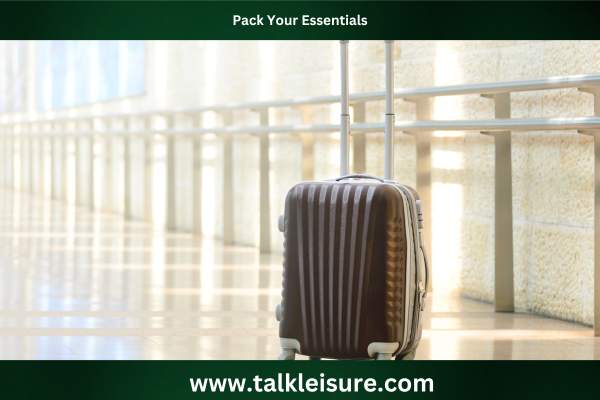Have you ever heard of POTS syndrome?
It’s a lesser-known medical condition that affects the autonomic nervous system, causing symptoms such as dizziness, rapid heartbeat, and fainting.
If you have been diagnosed with POTS syndrome, you may be wondering whether it’s safe for you to fly.
Indeed, the thought of being trapped in a metal tube at 35,000 feet can be daunting for someone with this medical condition.
So, can you fly with POTS syndrome?
In this blog post, we will explore the subject in greater detail to help you make an informed decision about travel.
Individuals with POTS experience a rapid heart rate and feelings of lightheadedness or faintness when standing up.
Given the nature of the condition, many people with POTS wonder whether they can fly safely.
According to experts, people with POTS can travel by air, but they may need to take certain precautions to manage their symptoms.
For instance, individuals may need to stay hydrated, avoid standing for long periods, and wear compression stockings to help regulate blood flow when flying after surgery (liposuction) or with POTS syndrome.
Individuals with POTS can still enjoy air travel with proper planning and preparation.
Flying in a hot air balloon during perfect weather is also a great experience. However, flying in a hot air balloon is not suitable for POTS syndrome patients as it may turn risky.
Can You Fly With The POTS Syndrome?

People with postural orthostatic tachycardia syndrome (POTS) can still travel by plane, but there are tips and precautions to keep in mind.
Hydration is crucial during travel, as dehydration can make symptoms worse.
Packing a bag of essentials with medications, compression garments, and salty snacks can help manage symptoms.
When booking a hotel, requesting a room near an elevator and on a lower floor is helpful.
Hotels must comply with the Americans with Disabilities Act, providing barrier-free access and designated rooms for people with disabilities.
Speak with a travel agent specializing in special needs to plan a vacation that works around your specific disability.
Remember to consult with a healthcare professional before traveling.
What Are The Tips For Travelling With POTS Syndrome?
Traveling with Postural Orthostatic Tachycardia Syndrome (POTS) can be challenging but possible with careful planning and preparation.
Individuals with POTS should consult their doctor before embarking on any travel to ensure they are safe to do so. By following the tips given below, individuals with POTS can travel safely and enjoyably.
Use A Wheelchair

For individuals with POTS syndrome, using a wheelchair for travel can be helpful.
It can conserve energy and reduce physical stress on the body.
When planning a trip, it may be beneficial to research rental wheelchair options and make the necessary arrangements.
Contacting the airline or travel provider to inform them of your need for a wheelchair can ensure a smoother travel experience.
When boarding a plane, individuals can request a wheelchair to assist with navigating the airport and getting to their seats.
It is important to note that using a wheelchair does not mean giving up independence or mobility.
It can actually offer a greater sense of freedom and comfort while traveling.
Keep Yourself Hydrated

When traveling with POTS, it is crucial to stay hydrated.
Dehydration can worsen symptoms and make travel more uncomfortable.
It is common for people to reduce their fluid intake to avoid frequent trips to the restroom while traveling, but this should be avoided.
POTS patients should continue to hydrate as much as possible, especially during travel.
Drinking plenty of fluids and water the day before travel is recommended to delay dehydration.
Keeping hydrated is essential to managing the symptoms of POTS.
Pack Your Essentials

When traveling with POTS syndrome, it is important to pack a bag of essentials to manage symptoms while away from home.
This should include all necessary medications, electrolyte replenishers, and compression garments.
Salty snacks or SaltStick Vitassium Salt Capsules can also be packed if one takes salt supplements.
Other helpful items to include are cool clothes, cool compresses for hot destinations, and a heart rate monitor or Sea-band wristbands for nausea relief.
By packing these essentials, those with POTS syndrome can travel safely.
Purchase A Medical ID Bracelet

One important tip for those traveling with POTS syndrome is to consider purchasing a medical ID bracelet.
This bracelet can be especially helpful in an emergency, allowing first responders to quickly and accurately provide proper care.
It is recommended to include personalized engravings on the bracelet, such as information about your POTS syndrome, drug allergies, severe allergies, medical devices, and specific instructions for movement.
Wearing a medical ID bracelet, you can feel more secure and prepared during your air travel with POTS syndrome.
Wear Comfortable Clothes

One important factor to consider when traveling with POTS syndrome is to wear comfortable clothes.
Choosing soft, stretchy, and loose-fitting clothing that allows for ease of movement is essential, which is important to maintain good circulation.
Cutting off any itchy tags that can irritate sensitive skin is also advisable.
It’s best to avoid wearing tight-fitting clothes or jeans during travel days, as they may impede blood flow and cause discomfort.
By wearing comfortable clothes, one can reduce the risk of symptoms and make their journey more enjoyable.
Carry Mobility Aid
When traveling with POTS syndrome, it’s always best to be prepared.
One important aspect to consider is the use of mobility aids.
If someone with POTS does not use a mobility aid daily but may need one during travel, it’s a good idea to bring one along.
A mobility aid can help with walking long distances or standing for extended periods.
This can greatly reduce fatigue and prevent fainting spells.
Such aids include canes, walking sticks, walkers, or even an electric scooter.
However, it is important to research travel restrictions regarding mobility aids before taking them on a trip.
By having a mobility aid on-hand, a person with POTS can enjoy travel without the fear of overexertion or injury.
Put On Compression Garments
When flying with POTS syndrome, it is important to remember to pack compression garments.
These garments can help improve circulation and reduce the symptoms of POTS syndrome, such as dizziness and fatigue.
Compression garments come in different forms, such as socks, stockings, and sleeves.
They apply pressure to the legs and help prevent blood pooling in the lower extremities.
POTS patients should consider wearing compression garments during travel and during prolonged periods of sitting or standing.
Choosing the right compression level and size is important for the best results.
Preparing for your flight
Preparing for your flight with POTS syndrome requires careful planning to ensure a safe and comfortable journey.
The first tip is to hydrate well before and during the flight to prevent dehydration, a common trigger of POTS symptoms.
Ensure all essential items for symptom management, such as medications, electrolyte replenishers, and compression garments, are packed in a carry-on bag.
Those with POTS syndrome can have an enjoyable travel experience with proper planning.
Apart from individual with physical disorders, those with mental illness may also fly on plane with proper planning.
Moreover, certain individuals with autism pursue their career as a pilot.
Take Breaks And Walk Around

Taking breaks and walking around regularly is essential when flying with POTS syndrome.
POTS patients should avoid prolonged sitting or standing as it can worsen symptoms such as dizziness, lightheadedness, and fatigue.
Walking around every hour or so during long flights or car rides can help improve blood flow and prevent blood pooling.
POTS patients can also consider doing simple exercises, like leg stretches or calf raises while sitting or standing still to help pump blood back up to the heart.
It’s also a good idea to request an aisle seat on flights to make getting up and walking around easier.
Bring Book Relevant Materials To Reduce Travel Anxiety
Bring relevant materials, such as books or podcasts, to help relax and distract the mind. This can be especially helpful during long flights or extended periods of travel.
Preparing for success means having these tools readily available on the day of travel.
Airports can also be overwhelming, but people are available to assist those with disabilities.
What Are Measures To Take When Flying With POTS Syndrome

Flying with POTS syndrome can present potential challenges.
This condition can cause dehydration, which can exacerbate symptoms.
To combat this, drinking more fluids than usual before and during the flight is important.
Wearing compression stockings and elevating the feet where possible can also be helpful.
It is important to avoid staying stationary for too long and take regular breaks to stretch and move around.
Requesting assistance at the airport can make the experience easier.
This may involve getting a fitness-to-fly letter or filling out a form from a healthcare professional.
Bringing snacks and meals can also be beneficial.
When flying with POTS syndrome or Trigeminal Neuralgia, it is best to avoid consuming alcohol.
By taking these measures, individuals with POTS can better manage their symptoms and have a more comfortable flying experience.
Final Thoughts
In conclusion, while flying with POTS syndrome can be challenging, it doesn’t mean that it’s impossible.
With proper preparation and the necessary tools, individuals with POTS can still enjoy their travels.
Hydrating well before and during the trip and packing a bag of essentials, including medications, electrolyte replenishers, and compression garments, are crucial.
It’s also essential to wear comfortable clothes and consider bringing a mobility aid if necessary.
Moreover, a medical ID bracelet is recommended, especially for those prone to fainting.
It’s best to notify the airlines in advance to avail yourself of assistance navigating through the airport and boarding the plane.
Lastly, it’s essential to stay calm and not worry about what other passengers think.
By implementing these tips, individuals with POTS syndrome can lessen the likelihood of a flare-up of symptoms and enjoy air travel.
FAQs
Will Prolong Standing Trigger POTS Symptoms?
Postural Orthostatic Tachycardia Syndrome (POTS) is a condition that affects the autonomic nervous system, causing a range of symptoms, including rapid heart rate, dizziness, and fatigue.
Yes, standing for prolonged periods can trigger POTS symptoms, such as dizziness, lightheadedness, and a rapid heart rate.
In people with POTS, standing causes blood to pool in the legs, reducing blood flow to the brain and other organs. This can result in the symptoms associated with POTS.
Exercise can help improve POTS symptoms associated with standing. Regular exercise helps to improve blood circulation and increase the strength of the leg muscles.
Does POTS Symptom Worsen When Flying During Your Period?
This question has no clear answer since everyone’s experience with POTS syndrome can differ.
However, for some individuals, POTS symptoms may worsen during their menstrual cycle due to changes in hormone levels.
Your doctor can advise on managing your symptoms and may recommend specific precautions or medications for your trip.
It is especially important to consult your doctor if you are experiencing particularly severe symptoms or have any concerns about flying during your period.
Who Is Most Affected By POTS?
POTS can affect anyone, but it is more commonly seen in women, particularly those in their teenage years and early adulthood.
Reports suggest that up to 80% of POTS patients are female, often diagnosed between the ages of 15 and 50.
Generally, POTS can affect anyone, but it is more commonly seen in women and those with certain risk factors.












